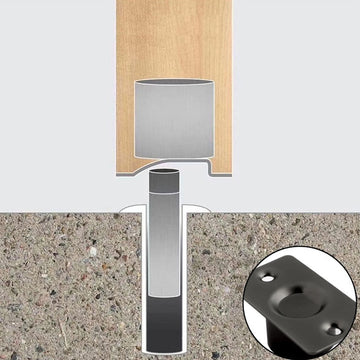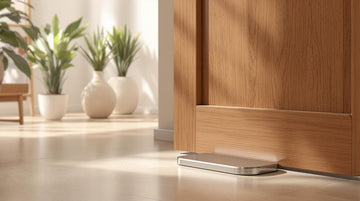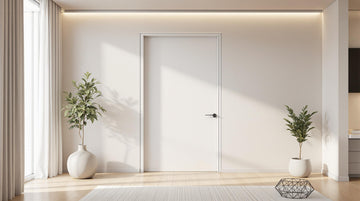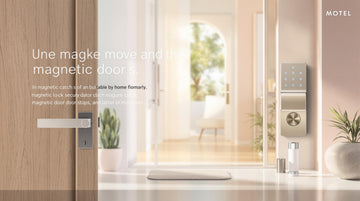Weighing Your Options: Magnetic Door Stoppers vs. Traditional Doorstops
by Square Table Marketing on May 03, 2023

Introduction
When it comes to keeping your doors in check, there are various options available, but one debate has been particularly prevalent: magnetic doorstop vs. traditional doorstops. This comprehensive guide will help you make an informed decision on which doorstop is right for your needs by diving into the nitty-gritty details of each type, their advantages and drawbacks, and answering some frequently asked questions. So, let's get down to brass tacks!
Magnetic Door Stoppers: The Modern Solution
The Lowdown on Magnetic Door Stoppers
Magnetic door stoppers are the new kids on the block and have quickly gained popularity due to their unique features and sleek designs. Let's take a closer look at what they bring to the table:
- Mechanism: Magnetic door stoppers utilize powerful magnets to hold doors in place, eliminating the need for manual wedging or propping.
- Design: These doorstops often come in sleek and modern designs, blending seamlessly with your décor.
- Installation: They can be easily installed on both the floor and the wall, providing versatile options for placement.
Pros of Magnetic Door Stoppers
- No tripping hazards: Since they don't protrude from the floor, magnetic door stoppers reduce the risk of tripping or stumbling.
- Child and pet friendly: With no small parts to pose choking hazards, magnetic door stoppers are a safer option for homes with little ones or furry friends.
- Damage-free: The magnetic mechanism prevents slamming doors, reducing the chances of damage to your walls and doors.
- Easy to clean: The lack of contact with the floor makes magnetic door stoppers a breeze to clean around.
Cons of Magnetic Door Stoppers
- Cost: Magnetic door stoppers tend to be more expensive than traditional doorstops.
- Installation: They may require drilling, which could be a drawback for renters or those hesitant to make permanent modifications.
Traditional Doorstops: The Tried and True Choice
The Basics of Traditional Doorstops
Traditional doorstops have been around for ages, and their simplicity is part of their charm. Here's what you can expect with a classic doorstop:
- Mechanism: Traditional doorstops typically use a wedge or a spring-loaded design to keep doors open.
- Design: They come in various shapes, sizes, and materials, from simple rubber wedges to decorative cast-iron options.
- Installation: Most traditional doorstops require little to no installation, making them an easy choice for many.
Pros of Traditional Doorstops
- Affordability: Traditional doorstops are often less expensive than their magnetic counterparts.
- Easy to move: With no installation required, these doorstops can be easily relocated to suit your needs.
- Versatility: Traditional doorstops can be used on various surfaces, including carpet, tile, and hardwood.
Cons of Traditional Doorstops
- Tripping hazards: Protruding from the floor, traditional doorstops can pose a tripping risk.
- Limited styles: While some decorative options exist, many traditional doorstops lack the modern appeal of magnetic door stoppers.
- Less secure: Traditional doorstops may be more prone to slipping or dislodging than magnetic options.
FAQs
- Are magnetic door stoppers strong enough to hold heavy doors? Yes, the strength of the magnets used in magnetic door stoppers is designed to hold even heavy doors securely in place.
- Can traditional doorstops damage my flooring? While some traditional doorstops may cause damage to certain flooring types, it's essential to choose a doorstop with a non-slip, non-marking base to minimize any potential harm.
Can a magnetic door stop be used on all door materials? A magnetic doorstop work best on metal doors, but they can also be used on wooden or glass doors by attaching a metal plate to the door, which will be attracted by the magnet.
Do traditional doorstops work well on carpeted floors? Traditional doorstops may not work as effectively on thick carpets, but there are options specifically designed for carpeted surfaces, such as those with a rubber base or those with a longer wedge.
How do I know which type of doorstop is best for me? Consider your specific needs, such as the door material, the surface it will be used on, your budget, and the desired aesthetic. Each type of doorstop has its own set of pros and cons, so weighing your options carefully will help you make the best decision for your situation.
Conclusion
At the end of the day, the choice between a magnetic door stop and traditional doorstops boils down to personal preferences and requirements. Magnetic door stoppers offer a sleek, modern, and secure solution with added safety benefits, while traditional doorstops are a cost-effective, easy-to-move option with a classic appeal.
By considering the pros and cons of each type, along with your specific needs and the frequently asked questions addressed above, you should be well-equipped to decide which doorstop will be the perfect fit for your home or office. So, go ahead and make an informed choice that suits your style and meets your requirements, ensuring that your doors remain under control and your space stays safe and functional.





